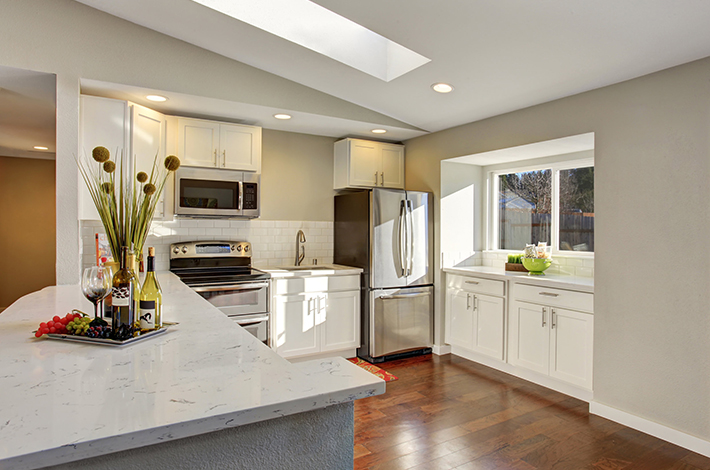When talking about materials for your kitchen or bathroom countertop, you probably heard of both quartz and quartzite and may have assumed they’re interchangeable. But these are two different materials and understanding the differences between them, as well as their limitations as a countertop material and strengths, is important to making the right decision for your countertop material.
The first thing to know is that quartz is a natural material while quartzite is man-made.
This can become important during your research as the process of creating quartzite can reveal its strengths as well as its flaws and, likewise, reveal some pitfalls in the natural quartz stone that quartzite was designed to correct as a countertop material option.
Below is some information about quartz and quartzite as countertop materials.
How is quartzite made?
Quartzite begins its life as sandstone. Since natural quartz is created through intense heat and pressure over an incredibly long period of time quartzite is created by speeding up this process. The sandstone is subjected to heat and pressure in a short period of time to produce crystals in the stone that mimic the look and feel of natural quartz. As part of the process the crystals that form are artificially bound together with resin and glass and some pigments are added as needed.
Do quartz and quartzite look the same?
It would be hard to mistake quartz for quartzite. In fact, quartzite is most often mistake for marble or for granite because of the patterning of the veins and the coloration. Quartz, on the other hand can look like almost any natural stone countertop and has a variety of colors and options that would have to be engineered in quartzite.
Are they structurally similar?
As you might imagine, a man-made countertop with artificial binding agents will not be as sturdy as a slab of natural stone. Quartz is going to be sturdier and stand up to more intense use than quartzite. Likewise, quartzite is more porous and requires sealing that quartz countertops do not. Quartzite should also be cleaned more regularly to account for the bacteria build up in the porous material.
Related Questions
What is the maintenance differences between quartz and quartzite?
Quartz requires virtually no maintenance beyond as-needed cleaning. Quartzite, on the other hand, is porous and requires sealing as well as attentive cleaning periodically to prevent bacteria building up in the porous parts of the stone.
Which material is more expensive?
Quartz is a fairly high-end material for countertops, however, quartzite’s added labor makes it more expensive between the two. This becomes even more true if you factor in any customizations you’re doing to your quartzite.
The choices seem to be endless and unless you know exactly what you want for your kitchen or bathroom countertops, its important to talk to a countertop professional. At Texas Granite Group located in the Austin area, we strive to make sure the countertop dreams of our clients are realized as well as surpass their expectations.
Full-service countertop sales and installation in Austin and beyond
With more than 20 years of experience in stone fabrication, we are certified to install countertops with the highest quality standard and customizing your kitchen and bathrooms to achieve an incredible appearance. Homeowners and business owners throughout Texas have made us a #1 choice for granite, quartz and marble countertops. Call us for a Free design consultation and you will quickly see why!

